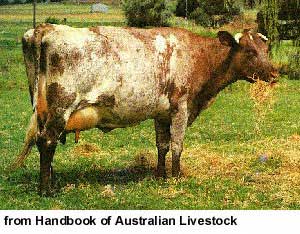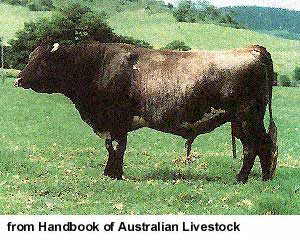Illawarra Cattle
 The word Illawarra is an Australian aboriginal word early settlers used, and is still
used today, to describe the land some 50 miles south of Sydney, land locked between
the Pacific Ocean and what was once a near impenetrable escarpment which rears abruptly
to the west. With few natural harbors it remained unexplored and unused until a big
drought in 1815, forced such settlers as Charles Throsby to seek new pastures.
The word Illawarra is an Australian aboriginal word early settlers used, and is still
used today, to describe the land some 50 miles south of Sydney, land locked between
the Pacific Ocean and what was once a near impenetrable escarpment which rears abruptly
to the west. With few natural harbors it remained unexplored and unused until a big
drought in 1815, forced such settlers as Charles Throsby to seek new pastures.
Even though the first land grants were made in 1816, it was not until the 1840s that dairying commenced as an industry, Cattle up till then were mainly raised for beef. Much of the land had cleared by the early settlers with the assistance of convict labor from the nearby penal settlement at Wollongong. All breeds types and colors of cattle had been introduced into the area.
Cattle grants from government and private herds reached the Illawarra. These included Longhorn Durhams, Shorthorn Durhams, Red Lincolns, Red Ayrshires and Jerseys. However, three members of the Osborne family from Northern Ireland had, since 1829, laid the foundations of a dairy industry, and in doing so, the evolution of the breed we know as (the Australian) Illawarras. They imported the best cattle, promoted the first Agricultural products, and dairy has remained an important Illawarra industry ever since.
The Illawarra breeders were credited with having a flair for stockbreeding and an "eye for a good beast".
The 1860s ushered in a new era about which records and facts became more accurately recorded. Several outstanding bulls had been imported and breeding aimed at evolving a dairy breed of cattle to suit the environment still earnestly pursued.
In 1898 the embargo was lifted allowing a fresh wave of cattle imports. Breeders introduced Jersey, Kerri Dexter, Friesian, Shorthorn and Ayrshire bloodlines and it was from this amalgamation that the Australian Illawarra dairy cattle descended.
 One Ayrshire bull, from Victoria, named "The Earl of Beaconsfield" proved outstanding
when mated with cattle of the Illawarra. The progeny was magnificent, and amongst
the most celebrated was a cow called "Honeycomb". Claimed to be Champion Dairy Cow
of the world in the early nineties, she was also invincible in the show ring and winner
of all the milk and butterfat awards. This was the cow that inspired the Illawarras,
and the breeding programs began revolving around Red and Roan Shorthorns.
One Ayrshire bull, from Victoria, named "The Earl of Beaconsfield" proved outstanding
when mated with cattle of the Illawarra. The progeny was magnificent, and amongst
the most celebrated was a cow called "Honeycomb". Claimed to be Champion Dairy Cow
of the world in the early nineties, she was also invincible in the show ring and winner
of all the milk and butterfat awards. This was the cow that inspired the Illawarras,
and the breeding programs began revolving around Red and Roan Shorthorns.
In 1910, dairymen met at Kiama to establish another Herd Book, under the title Illawarra Dairy Cattle. In turn the first published Herd Book appeared in 1919.
Milking Shorthorn and Illawarra Dairy Cattle Societies continued to flourish and expand throughout all Australian States. In Queensland the two breed Societies amalgamated to form the Illawarra Dairy Cattle Association of Queensland.
This lead to further interstate amalgamations until, after protracted negotiations over many years, a national body called The Australian Illawarra Shorthorn Society was formed in Brisbane in 1930. For many years they were referred to as the Illawarra Shorthorns, or "the A.I.S. cattle".
Now the term "Illawarras" is commonplace and the Society is called The Illawarra Cattle Society of Australia. The "Shorthorn" was dropped from the name because it caused confusion to some overseas buyers, who associate Shorthorns with dual-purpose animals. Illawarras are an excellent true dairy breed, hence the change of name.
Color
An Illawarra animal can be of a rich, whole red, a rich red with a little white on the flanks or body or a full rich roan. Broken colors are objectionable and black and brindle markings are not allowable.
Udder
The udder should be capacious but not pendulous, and well-attached back and front. The skin should be fine, elastic and of a nice orange tint, covered with short silky hair, and the milk veins pronounced and visible. The teats should be from 65mm-75mm long, placed evenly, brown in color, and underneath the vessel. Thin or bottle teats are objectionable.
Outline
Fairly light in front but increasing in depth and width towards the hindquarters, giving a wedge shape as viewed from front, behind or above the animal. The outline should be sharp and clean without any signs of beefiness in a cow in milk. There should be refinement and quality in the animal.
Production and Milk Quality
Illawarra are producers of large quantities of milk. Many cows produce in excess of 40 liters per day and 300 day lactations over 10,000 liters are not uncommon. Because of its moderate fat, high protein milk yield the breed is in an excellent position to take advantage of the growing world demand for protein.
Adaptability
Australian dairy cows are subjected to a wide range of climatic conditions. Whilst extreme temperatures in dairy farm areas vary from below 0C to over 40C, Illawarra cows thrive on a pasture based feeding system and are not housed at any time of the year. Consequently they have adapted well in countries extending from the Tropics to North America.
Calving Ease
One of the most outstanding features of Illawarra cows is their ability to calve unattended with assistance rarely ever needed. Contributing factors to this highly desirable characteristic appear to be their superior pelvic formation and individual determination.
Longevity
An Illawarra cow can be expected to calve at 2 years of age, calve regularly every 12 months increasing her yield each year until a mature cow and keep producing into her early teens. Many have produced lifetime totals in excess of 60,000 liters of milk.
Pigmentation
Illawarras have strong dark hooves and dark pigmentation of the skin, thus avoiding the problems of skin cancer and sunburnt teats. The latter being one of the contributing factors to the reputation of Illawarras having an excellent temperament.
References
The Illawarra Cattle Society of Australia Limited, P.O. Box 189, Kiama, N.S.W. 2533, Australia
Phone: (02) 4232 3333
Fax: (02) 4232 3350
